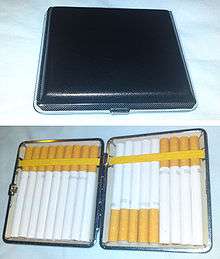Cigarette case


A cigarette case (sometimes called a cigarette tin) is a sturdy container used to store small numbers of cigarettes and prevent them from being crushed. A typical cigarette case is a flat box (commonly made of metal) that opens symmetrically into two halves. Each half stores a row of cigarettes, which are often held in place by a spring or an elastic strap. Some cigarette cases are simply sturdy cases used to store standard cigarette packs.
In modern times cigarette cases are also made of plastic. Some cigarette cases come with additional features, such as built-in lighters or ashtrays.
A cigarette box, much like a cigar humidor, is a larger item often stored on desktops or coffee tables. Made of wood, metal, glass, or ceramic, a cigarette box holds a larger number of cigarettes for use by the homeowner and guests.
Typical cigarette tins in the United States of the 1920s–1930s stored 50 cigarettes. Because of this, they were sometimes referred to by the nickname "flat fifties".[1]
Cigarette cases are fashionable accessories within smoking culture. As such, they may be made of precious metals, adorned with artistic engravings, monograms,[2] and jewels. Peter Carl Fabergé, while most famous for his Fabergé eggs, also manufactured exquisite cases of gold and gems for the family of the Tsar,[3] some of which (e.g. those owned by Danielle Steel) are reportedly worth up to $25,000.[4]
At the opening of each of his new Broadway productions, Cole Porter's wife, Linda, presented him with a cigarette case from Cartier. Each was more beautiful than the last, in gold, silver or leather, many studded with gems and generally styled to relate to that show's theme. Cigarette cases are also collectible items.[3]
Common "silver cigarette cases" are most often chrome-plated, although there are silver-plated or polished aluminum cases[5] in addition to genuine sterling ones.
Cigarette cases used to be popular with soldiers, and many World War I and World War II veterans (e.g., James Doohan) stated that cigarette cases saved their lives by stopping bullets.[5]
In 2003 the European Union witnessed a surge in cigarette case sales, attributable to the introduction of prominent black-bordered warning labels on cigarette packs, e.g., "Smokers Die Younger", etc., by an EU directive in January 2003. Cigarette cases were a way to avoid the invasive labels (another way being various satirical stickers, with slogans such as "You could be hit by a bus tomorrow").[5]
The United States Census Bureau, for the purposes of industry statistics, includes manufacturing or adorning of cigarette cases in the category NAICS 339914 "Costume jewelry and novelty manufacturing".[6]
Due to the compactness of a cigarette case, being just small enough to conveniently fit in a pocket, they can also be used to store or conceal other small items.
In popular culture
- In some of the James Bond films, Bond is issued gadgets which are concealed in cigarette cases.
- In the 1987 Disney TV movie Double Agent, the lead character, a spy, carries a cigarette case filled with licorice.
- In the film Black Swan, Lily uses a cigarette case.
- In the film Constantine, John Constantine uses a cigarette case.
- Francisco Scaramanga, the antagonist in the 1974 film The Man with the Golden Gun, assembles his signature weapon the Golden Gun from a cigarette lighter, a pen and a cigarette case.
- The Team Fortress 2 spy class is equipped with a disguise kit hidden inside his cigarette case, which he can use to disguise himself as an enemy.
- In Boardwalk Empire the main character Nucky Thompson can often be seen with a cigarette case.
- In Chinatown, the protagonist, J.J. Gittes, carries around a cigarette case.
- In the film Titanic, the valet, Mr. Lovejoy, uses a cigarette case.
- In Community the character Troy Barnes can be seen storing candy cigarettes in a cigarette case.
- In the Hindi film Don, Jasjit, one of the main protagonists, is implicated in an armoured van robbery after he drops his ornate custom cigarette case in the van.
- In the television series House of Cards, the Underwoods use a cigarette box.
See also
- Cigar box
- Cigar case
- Humidor
- TKB-506 (a Soviet noiseless pistol disguised as a cigarette case)
References
- ↑ "Campus Publicity", January 28, 1935, Time
- ↑ "Dedications on Silver Cigarette Boxes, an article of Association of Silver Collectors
- 1 2 "Smoking Related Collectables", originally published in the UK monthly magazine What It's Worth?)
- ↑ Vickie L. Bane, Lorenzo Benet (1995) "The Lives of Danielle Steel: The Unauthorized Biography of America's #1 Best-Selling Author" ISBN 0-312-95575-8 p. 340
- 1 2 3 Day, Elizabeth (October 15, 2003). "Film star glamour of cigarette cases hides truth for smokers". The Daily Telegraph. Retrieved 2009-01-14.
- ↑ NAICS 339914
